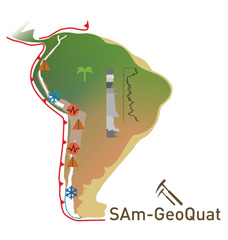

During the Quaternary, a series of landforms and sedimentary deposits evolved in South America (SA) in response to major tectonic and surficial processes. In the Andean region, tectonic and volcanic processes generated significant changes in the landscape, in interaction with glacial, physical weathering, fluvial and mass transports processes. For intraplate extra-Andean SA, surface deformation occurred also at unexpected locations, but with relative slow displacement rates. On a regional or sub-continental scale, the state of knowledge on the interactions between climatic forcing, tectonics and volcanism during the Quaternary in SA is segmented because of the scarce integration between geoscientists working in the different sub-disciplines. This can conduct to biased palaeoenvironmental reconstructions. Also, regional temporal analyses rely on the recognition of morphostratigraphic units, in some cases without an absolute chronological control.
Field meetings and workshops allow many researchers with different geological backgrounds to meet and discuss common approaches for studying the interactions between Quaternary climatic forcing, tectonics and volcanism along a variety of tectonic settings of the continent. The main objective of the project in 2013 is to enhance integrated analyses in three main target regions of the continent: the Southern Altiplano-Puna Plateau (Central Andes), the Pampean Ranges and North Pampa Plain, and the Passive Margin of the continental intraplate part (extra-Andean South America) mainly through field discussions and integrated studies. From cross-disciplinary and cross-regional correlations, advances related to those interactions during the Late Quaternary will be produced.
The Central Andes (4°-46° 30'S) show a wide variety of Quaternary tectonic styles and settings, mainly controlled by subduction processes through the collision of the Nazca and SA plates. Into the normal subduction segment (14°-27°S) and between their main morphostructural units, the Southern Altiplano-Puna Plateau is important to enhance integrated analyses of the tectonic-volcanic vs. climatic interplay on the Quaternary landscape evolution. The Pampean flat-slab segment (27°-33°S) (the active Andean front and the Pampean Ranges, a broken foreland adjacent to the Andean orogen) concentrates more than 90% of the Quaternary deformation documented in Argentina (Costa et al., 2000; 2006). This latitudinal section is a key area for integrated tectonic and climatic processes studies. Researches on Quaternary deformation along the intraplate domain of SA are incomplete and not well documented in some areas. Field discussions along a transect from the Pampean Ranges to the Paraná river valley, crossing the North Pampa, can enhance integrated interpretations on the Late Quaternary processes. In the Brazilian platform, several examples of Quaternary tectonics have been reported. Seismically they have very long recurrence intervals, although recent studies have highlighted their capability of producing surface ruptures as well as liquefaction (Bezerra et al., 1998, Riccomini and Assumpção, 1999, Bezerra and Vita Finzi, 2000). Geological proxies pay the way for subsequent palaeoseismological studies in order to obtain more accurate measurements of slip rates and recurrence periods of co-seismic displacements. Evidences of Quaternary deformation exist in craton-related basins (Amazonas, Pantanal and Paraná basins), been areas for the analyses of tectonics and fluvial processes interaction.
This is a collaborative project of mutual interest; with most of the participants are developing-country researchers from SA institutions that in general have limited resources to keep their involvement in international scientific activities. The planned workshops in Brazil and both field training course/meetings to be organized in Northwestern and Central Argentina and corresponding to the target areas of the project (2013) will provide excellent opportunities to present results to a range of appropriate scientists, and to discuss on problems, interpretation and correlation between regions. The possibility to offer grants from this INQUA project to young researchers is highly valuable on this continent, with relative minor offers of this kind of initiatives.
Target zones will be extended in other regions of SA in 2014 and 2015 as the activities progresses and other participants of the project are willing to get more involved. One of the main confirmed activities for 2014 is the organization of the International Fieldtrip Meeting in Venezuela (from Venezuelan Andes to the Llanos) -Dr. M. Bezada, main coordinator-. The analysis of the role of the neotectonics and the climatic changes on key representative sections of SA will be discussed to produce, as a collective of authors, a series of research results and papers that exceeds the own geological disciplines (2014/2015).








